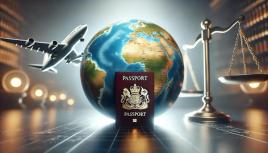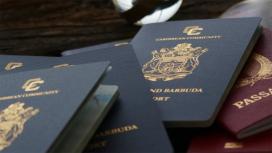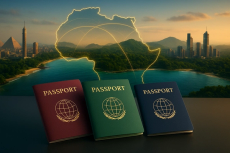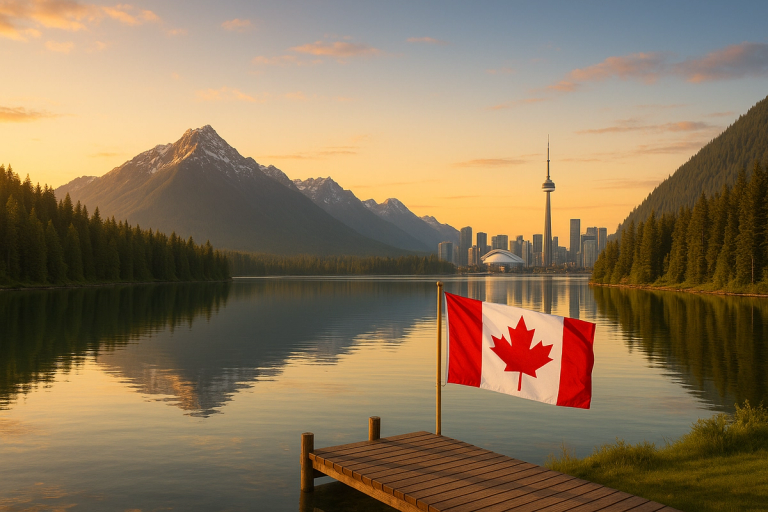Blog • Published on:August 25, 2025 | Updated on:September 18, 2025 • 12 Min
How to Invest Your Way to Canadian Citizenship
More than one in five people living in Canada today are foreign-born, making it one of the most immigrant-driven countries in the world. For investors and entrepreneurs, that openness translates into structured immigration programs that reward business creation, job growth, and capital investment.
Canada no longer runs a “buy-a-passport” style Citizenship by Investment program like some other countries. Instead, investors can access permanent residency, and later citizenship through routes such as the federal Start-up Visa and the Self-Employed Persons Programs, or provincial entrepreneur streams. Quebec also maintains its own investor pathway with distinct criteria.
What sets Canada apart is the balance: the chance to secure long-term residency for the entire family, access world-class healthcare and education, and integrate into the 10th strongest economy in the world, all while building or investing in real businesses.
This guide explores how those programs work, what the requirements look like, and how investment leads to a Canadian passport over time.
Overview of Canadian Investment Immigration Programs
Canada’s approach to investment immigration is not a single unified program but a set of federal and provincial pathways.
Each program is designed to attract entrepreneurs, business owners, and investors who can contribute to the economy while building a life in the country.
Pathways Available
- Federal programs: These include the Start-up Visa Program (for entrepreneurs backed by Canadian venture capital or angel investors) and the Self-Employed Persons Program (for cultural or athletic professionals)
- Provincial Nominee Programs (PNPs): Provinces like British Columbia, Ontario, and Quebec run their own entrepreneur and investor streams, often with tailored requirements based on local economic needs
Investment Thresholds
- Minimum investment amounts typically start around C$200,000 for provincial entrepreneur streams
- Quebec’s Immigrant Investor Program (QIIP),, requires an investment of C$1.2 million Federal programs, like the Start-up Visa, don’t require direct cash investment but instead require you to secure backing from accredited investors and sufficient settlement funds
Processing Times
- Federal programs such as the Start-up Visa may take up to 52 months for processing
- Provincial streams vary widely, often ranging from 15–24 months, depending on quotas and the applicant’s profile
- The journey from investment to citizenship takes 5 years Benefits of Canadian Citizenship by Investment
For many investors, the end goal isn’t just permanent residency, it’s Canadian citizenship.
A Canadian passport brings with it a mix of lifestyle perks, global mobility, and business advantages that few other countries can match.
Social Benefits and Healthcare
Citizens have full access to Canada’s publicly funded healthcare system, consistently ranked among the best in the world.
Beyond that, citizens also qualify for social security benefits, pensions, and unemployment support, creating a strong safety net for families.
Visa-Free Travel Privileges
A Canadian passport opens the door to visa-free or visa-on-arrival travel to over 180 countries, including the United States, the EU, Japan, and Australia.
This makes it one of the most powerful travel documents globally.
Education Opportunities
Citizens enjoy reduced tuition fees at Canadian universities, which are already among the world’s most respected.
Children of citizens can access subsidized primary and secondary education, while international students pay much higher rates.
Business Advantages
With citizenship, investors gain full access to the North American market, trade benefits under agreements like USMCA, and the ability to expand operations without restrictions.
Canada’s stable banking system and transparent regulations make it an attractive base for global entrepreneurs.
Thinking about kicking back in the Great White North? Canada’s not just for the young and upwardly mobile, it's an awesome spot for retirees too! Want to see what that looks like? Read our full guide here: Retire in Canada: Immigration Guide & Requirements
Federal Business Immigration Programs
Canada’s federal immigration pathways are designed to attract people who can actively contribute, whether by building a business or bringing unique expertise.
Here are the main routes:
1. Start-up Visa Program
- Purpose: For entrepreneurs with innovative, scalable business ideas
- Requirements:
- Secure C$275,000 from a designated venture capital fund
- Alternatively, gain acceptance into a designated business incubator
- Meet CLB 5 in English or French and show proof of settlement funds
- Processing time: About 52 months
2. Self-Employed Persons Program
- Purpose: For individuals with experience in cultural or athletic fields who can enrich Canada’s arts, culture, or sports
- Requirements:
- At least two years of relevant self-employment or international experience
- Demonstrate the ability to sustain yourself and contribute to Canadian society
- Processing time: Generally 60 months, due to case-by-case evaluation
3. Federal Investor Program (Historical Context)
- Once one of the most popular immigration options (1986–2014)
- Required investors to make large passive contributions into government funds
- Permanently shut down in 2014; no passive federal investor program exists today
- Quebec remains the only province offering an investor-focused route (with stricter terms)
Provincial Nominee Programs (PNP)
Alongside federal routes, Canada’s provinces and territories run their own investment and entrepreneur programs.
These allow investors to establish or buy businesses at the local level, with the chance to transition into permanent residency.
Requirements vary, but most programs expect active management, job creation, and a minimum net worth.
1. Quebec Immigrant Investor Program (QIIP)
- Status: Canada’s most established investor pathway, though it has faced pauses and reforms in recent years
- Requirements:
- Invest C$1.2 million (at zero interest) for 5 years through an approved financial intermediary
- Demonstrate a legally acquired net worth of at least C$2 million
- Significant business or management experience required
- Processing time: 10 months to citizenship
2. British Columbia PNP Entrepreneur Stream
- Investment threshold: Minimum C$200,000 in a new or existing business
- Net worth: Minimum C$600,000
- Conditions: Must create at least one job for a Canadian citizen or permanent resident
3. Other Provincial Options
Many provinces, such as Manitoba, Saskatchewan, and Nova Scotia, offer entrepreneur or farm investor streams. Most follow a similar model:
- Minimum investment of C$150,000–250,000
- Net worth requirements of C$500,000+
- Active participation in business management
Investment Requirements and Financial Criteria
Each Canadian investment immigration program comes with its own set of financial and professional requirements.
While the exact thresholds differ between provinces and federal routes, there are some common criteria that applicants should be prepared for.
Minimum Investment Amounts
- Provincial streams usually require C$150,000–250,000 for smaller regions and C$200,000–600,000 in major cities like Toronto or Vancouver
- Quebec Investor Program sets the bar higher, requiring a C$1.2 million passive investment
- Start-up Visa Program does not require personal investment but demands backing from an approved venture capital fund, angel investor, or incubator
Net Worth Requirements
Most provinces want applicants to show they have the means to support both their investment and their family:
- Ranges typically from C$400,000 (smaller provinces) to C$2 million (Quebec)
- Proof must include bank statements, property valuations, securities, and other assets, with a clear record of legal acquisition
Business Experience Prerequisites
- Applicants are expected to have at least 2–3 years of management or ownership experience
- Quebec and Ontario specifically require proven track records in running a business or managing a large enterprise
- Start-up Visa applicants need a viable innovative business plan supported by accredited investors
Job Creation Obligations
- Most provincial entrepreneur streams require the creation of at least one full-time job for a Canadian citizen or permanent resident
- In larger provinces or higher investment categories, the requirement can increase to two or more jobs
- Quebec’s investor route is unique because it does not require job creation, only the passive investment
Application Process for Canadian Investment Immigration
While requirements vary between federal and provincial programs, most investor and entrepreneur applications follow a similar sequence.
The process is structured to ensure applicants meet eligibility, financial, and residency standards before transitioning into permanent residency.
1. Initial Assessment
Applicants first undergo a preliminary evaluation to determine which program best fits their profile. This involves reviewing personal net worth, business background, and language skills.
Many provinces also use an Expression of Interest (EOI) system, where candidates are ranked before invitations are issued.
2. Document Preparation
Once selected, applicants must prepare a complete file of supporting documents. This typically includes:
- Proof of net worth and legal asset acquisition
- Business ownership or management records
- Educational and professional credentials
- Police clearance and medical certificates for family members
- Language test results (where required)
3. Investment Verification
For entrepreneur streams, applicants are asked to sign a performance agreement committing to the required investment and job creation.
For Quebec’s investor program, the investment must be placed with a government-approved intermediary.
In the case of the Start-up Visa, verification comes from the designated investor or incubator.
4. Permanent Residency Process
After provincial or federal approval, applicants receive a nomination certificate (for PNPs) or a Letter of Support (for Start-up Visa).
With this, they apply for Canadian permanent residency through Immigration, Refugees and Citizenship Canada (IRCC).
- Processing times: usually 52+ months, depending on the stream
- Approved applicants and their families are granted permanent resident status, a crucial step before citizenship eligibility
Pathway from Investment to Citizenship
Securing permanent residency through an investment or entrepreneur program is only the first stage. To become a Canadian citizen, applicants must meet residency, language, and knowledge requirements before submitting a citizenship application.
Permanent Residency Period
After approval, investors and their families receive permanent resident (PR) status. PR holders enjoy almost all the rights of citizens, healthcare, education, and work, except voting and holding public office.
Physical Presence Requirements
To qualify for citizenship, PR holders must:
- Live in Canada for at least 1,095 days (3 years) within a 5-year period before applying
- Spend a minimum of 183 days per year in Canada during those years to show genuine residency
Language Proficiency
Applicants aged 18–54 must demonstrate proficiency in English or French. The required level is CLB 4 or higher, which represents basic conversational ability. Accepted tests include IELTS, CELPIP, or TEF for French.
Citizenship Test
Applicants aged 18–54 must also pass a citizenship exam that covers:
- Canadian history
- Rights and responsibilities of citizens
- Knowledge of Canadian laws, government, and symbols
Those over 54 or under 18 are exempt from the test
Business and Investment Opportunities in Canada
Beyond immigration, Canada offers investors a stable and diverse economy with strong growth potential.
Understanding where opportunities lie can help applicants not only meet program requirements but also build profitable ventures.
Key Industries for Investment
Canada’s economy is broad, but several sectors stand out for foreign investors:
- Technology & Innovation: Toronto, Vancouver, and Montreal are among North America’s fastest-growing tech hubs, with strong demand for startups in AI, fintech, and biotech
- Natural Resources & Energy: Mining, forestry, oil, and clean energy remain central pillars of the Canadian economy
- Agriculture & Agri-tech: Provinces like Saskatchewan and Alberta offer significant opportunities in farming, food production, and agri-tech innovation
- Healthcare & Life Sciences: With government backing and global partnerships, the biotech and pharmaceutical sectors continue to expand
Strategic Business Locations
- Toronto: Canada’s financial hub and North America’s second-largest tech cluster
- Vancouver: A gateway to Asia-Pacific trade, with strong real estate and clean energy sectors
- Montreal: Known for aerospace, gaming, AI, and research-driven innovation
- Calgary & Edmonton: Centers for energy, resources, and agribusiness
Market Analysis
- Canada is part of the USMCA trade agreement, giving businesses preferential access to the U.S. and Mexican markets
- Stable financial regulations and a banking system ranked among the safest in the world create confidence for investors
- A skilled, multicultural workforce makes Canada a strong base for scaling internationally
Legal Considerations and Compliance
Investors moving to Canada must be prepared not only to meet immigration requirements but also to comply with Canadian legal and financial obligations. Understanding these early helps ensure a smooth transition and long-term success.
Tax Obligations
- Canada taxes residents on worldwide income, unlike some jurisdictions where only local income is taxed
- However, Canada has tax treaties with more than 90 countries, which help reduce the risk of double taxation
- New residents are required to file annual income tax returns and report all foreign assets if they exceed C$100,000 in value
Business Registration Requirements
- Entrepreneurs must register their business federally or provincially, depending on the scope of operations
- Each province has its own incorporation rules, business name registration process, and licensing requirements
- Compliance with employment laws, payroll contributions, and provincial regulations is mandatory once a business is operating
Investment Monitoring
- Many provincial nominee entrepreneur streams require applicants to sign a performance agreement, outlining investment amounts, job creation targets, and timelines
- Authorities may conduct periodic checks to confirm that the applicant has fulfilled their obligations
- Failure to meet these requirements can result in the withdrawal of the provincial nomination or permanent residency application
Family Immigration Benefits
One of the strongest draws of Canada’s investment immigration programs is that they extend beyond the main applicant.
Spouses and dependent children are usually included, allowing families to relocate and settle together.
Spouse and Dependent Inclusion
- Both spouses and dependent children under 22 years old can be included in the initial application
- Adult children over 22 may also qualify if they are financially dependent due to physical or mental conditions
Education Benefits for Children
- Children of permanent residents and citizens have access to free public education through primary and secondary school
- Post-secondary education is heavily subsidized for citizens, meaning tuition at Canadian universities is often two to three times lower than what international students pay
Family Reunification Options
- After obtaining permanent residency or citizenship, investors can sponsor other close family members, such as parents and grandparents, through Canada’s family reunification programs
- This creates a long-term pathway for extended family to join and settle in Canada
Your Pathway to a New Life in Canada
Investing in Canada is more than a route to residency or a passport, it’s a chance to build a secure future in one of the world’s most stable and welcoming countries. From healthcare and education to global business access, Canada offers opportunities that extend far beyond immigration status.
If you’re ready to explore your options, Savory & Partners is here to help you navigate the process with clarity. From assessing eligibility to preparing applications and guiding you after arrival, our team ensures that your journey to Canada is smooth, compliant, and aligned with your goals.
FAQs on How to Invest in Canada
1. How long must I live in Canada before applying for citizenship?
You must be physically present in Canada for at least 1,095 days (three years) within the five years before applying.
2. What are the eligibility requirements for the Start-up Visa Program?
You need a qualifying business, a Letter of Support from a designated venture capital fund, angel investor, or incubator, proof of settlement funds, and basic English or French (CLB 5).
3. What does the Quebec Immigrant Investor Program (QIIP) require
Applicants must show a legally acquired net worth of around C$2 million, invest C$1.2 million for five years (or use financing from C$350,000), and have at least two years of management or business experience.
4. What’s needed to maintain permanent resident (PR) status in Canada?
You must live in Canada for at least 730 days (two years) within every five-year period to keep PR status.
5. Do Canadian residents pay taxes on worldwide income?
Yes. Canadian residents are taxed on their worldwide income, but tax treaties and credits help prevent double taxation.
References
Government of Canada. (2025). Start-up Visa Program: Eligibility. Immigration, Refugees and Citizenship Canada. Retrieved from https://www.canada.ca/en/immigration-refugees-citizenship/services/immigrate-canada/start-visa/eligibility.html
Government of Quebec. (2025). Conditions of the Immigrant Investor Program. Gouvernement du Québec. Retrieved from https://www.quebec.ca/en/immigration/permanent/immigrate-business/investors/conditions
Government of Canada. (2025). Permanent resident status: Residency obligations. Immigration, Refugees and Citizenship Canada. Retrieved from https://ircc.canada.ca/english/helpcentre/answer.asp?qnum=727&top=4
PwC. (2025). Canada: Taxes on personal income. PwC Worldwide Tax Summaries. Retrieved from https://taxsummaries.pwc.com/canada/individual/taxes-on-personal-income
Written By

Laura Weber
Laura Weber is a legal expert in international tax planning and citizenship by investment. With over a decade of experience, Laura helps individuals and families navigate complex legal frameworks to secure dual citizenship and global residency options, particularly in the Caribbean and Europe.
Related Articles









Recently Published









Book a free consultation


